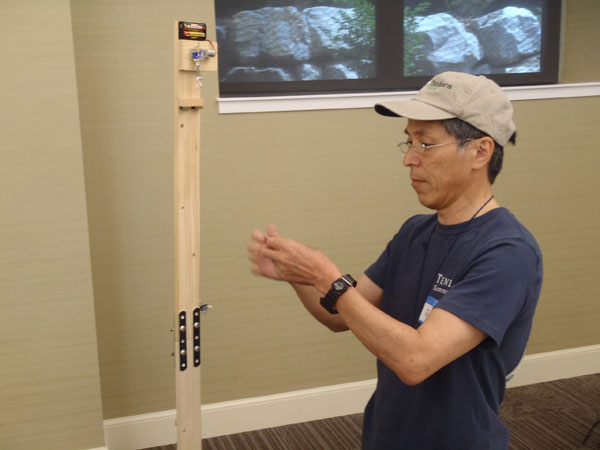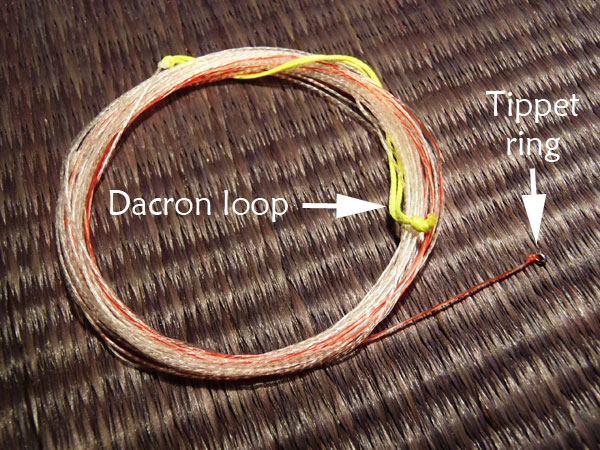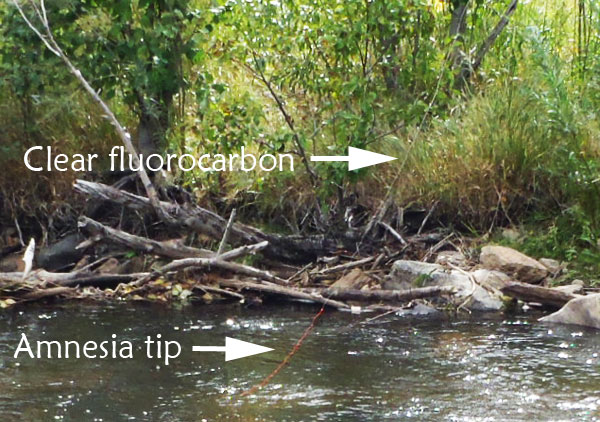Over the weekend, I got a chance to field test a prototype line made by John Veterlli of Tenkara Guides. It’s a hybrid line based off of a formula invented by master Japanese tenkara angler Eiji Yamakawa (a.k.a. “Eddie” on the Tenkara USA Forums). While I’ve pretty much been fishing tenkara level lines exclusively over the last couple of years, this line made me reconsider tapered, furled lines…
Yamakawa’s Tenkara Line
I happen to have a 20 ft. furled line Yamakawa-san sent me some time ago. Shamefully, I haven’t fished it yet, but I will now that my interest in furled lines is piqued and I’ve dabbled in it myself. Yamakawa’s formula goes like this and is made of clear fluorocarbon:


John’s Tenkara Line
John adapted Yamakawa’s formula and added a strand of Amnesia to the last section for higher visibility. The formula for a 16 ft. line (at least for the prototype I have) is this from butt to tip:
- 2 sections of 1X fluorocarbon made up of 3 strands
- 1 section of 2X fluorocarbon made up of 3 strands
- 1 section of 2 strands of 3X fluorocarbon and 1 strand of 6lb red Amnesia
So how does it cast? Beautifully! I forgot how much of a joy a tapered, furled line is to cast. It’s not “whippy” like a level line. It’s very elegant and smooth–more like a tapered western double-taper fly line. The difference is conspicuous. Still, any furled tenkara line made out of anything other than a material with no stretch (like Kevlar) will turn into a bird’s nest after being pulled out of a snag. But if you can live with that, these are good lines. Until Kevlar came along, we all had been living with it and no one seemed to complain about it too much so maybe it’s a non-issue if you like the way the line casts.
Some other features of John’s line include a 20 lb. dacron loop to make a girth hitch connection to the lilian and a tippet ring.

The Bottom Line
Soon, both Yamakawa’s line and John’s variation will be available on the Tenkara Guides website. Yamakawa’s original formula will be available under the name “Sensei”, while John’s modified line will be called “Senpai”. Personally, I like the Senpai line prototype a lot. John says he’s still “dialing it in” so I’m not sure what the final product will be but if the prototype is any indicator, I think there will be a new line on the market that is attractive to both tenkara newbies and experts alike.









I wonder what it would be like if you used the hi-viz sunline fluorocarbon line. I have wanted a longer line to use that is easier to cast. Looks like I will have to get me a few of these.
Hi Michael,
I think you could but it wouldn’t be as high-vis. I think the intention here is to take advantage of the brightness of Amnesia, yet compensate for its lower density by furling it in with some heavier fluorocarbon. The best of both worlds.
I have tried the sunline, the thickness and stiffness didn’t work well with the rest of the line. The visibility was not as good either. I am waiting for some other hivis materials to arrive from Japan to test in another prototype. I am up to 6 different prototypes right now and each one is getting closer to what I want the lines to do performance wise.
John, looking forward to trying out your line!! Thanks for the info, Jason.
Ashley, if you want one just email me & johnnyv145@gmail.com
this looks like an interesting way to go ,if i can ever learn how to furl properly,lol
I am working on a line making page for the tenkaraguides.com website. It is a very detailed project and is taking me longer than expected to get it done and done right. There will be features from other line makers showing different furling/twisting methods and line materials. The plan is for people to be able to learn various methods and find a method of line making that works for them.
Jason was also drafted to participate in this project, thanks Jason for your help.
Thanks John. I talked to Karel and we will have a video soon. It will be a fun project that will definitely benefit the Tenkara community!
sounds like it will be aa great site ,cant wait
The Sensei Eddie Series lines are available now. Contact me johnnyv145@gmail.com
Lines are built to order price varies on length of line contact me for pricing.
Hybrid lines are still in R&D and will be available soon.
Do you have a close up pic of his jig? Looks to be a motor at the top that helps get his furl tighter.
Sorry, don’t have a close up. There is a motor. I have a video I took at the summit of him using it I can try to put up soon. It was a very interesting set up.
I am working on videos this week that show Eddie’s machine in detail. After Eddie taught me how to make his lines, he gave me the machine shown in the pic above.
It is constructed out of 3 pieces of 2″ X 5/8″ inch pine joined by 6 steel plates and screws/wingnuts. The entire machine breaks down into a compact package about 22 inches in length and about 4.5 inches in diameter.
There is a small motor and AA battery pack mounted to the top of the machine. The motor is a small electric RC car motor. At the bottom of the top piece of the machine is a small toggle switch to turn the motor on/off.
Eddie’s machine is a marvel in simplicity in both construction and operation. The key component of Eddie’s design are 2 small 2 X 2 inch plastic plates that separate the fluorocarbon strands and helps regulate how tight the lines are twisted together.
These plates make the lines very uniform in tension, and diameter.
When I get the line making page up and running on tenkaraguides.com, I will try to get a detailed component list for the machine so those that are interested can build their own.
My partners EriK and Rob are working on 2 other machines with some different design ideas. It should be interesting to see what they come up with.
If anybody has questions about the machine, the formula, the method of making these lines, feel free to email me & I will share all that I know. There are no secrets with these lines. Eddie and I want people to learn and enjoy making their own lines. It’s just like learning to tie your own flies.
It adds one more dimension to your fishing enjoyment.
I only offer them for sale because it is one more way to make them available outside of Japan. Eddie spent the better part of a decade designing these lines. They are the work of a master craftsman. I consider myself simply Eddie’s American Apprentice and hope that many more people get to experience the simple beauty of how these lines perform.
My email is: johnnyv145@gmail.com